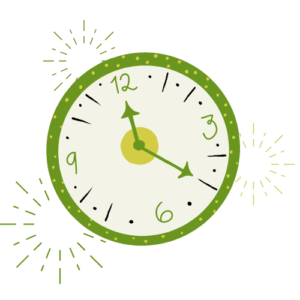Excuses are the nails used to build a house of failure. —Jim Rohn
Spoiler alert: this one’s a bit longer.
Think of it like a slow-cooked Sunday stew — not a microwaveable meme. 😉
Part of my intention with Sunday Seeds is to get you to pause — to read, think, savor, maybe even bring it up in conversation over coffee or a walk. If carving out 5–10 minutes to read and reflect feels like too much…be honest with yourself. And then ask: Why?
And hey, if my writing feels a bit “chewy” or not quite your flavor, that’s okay too. There are plenty of inspirational quotes and quips floating around your feed. Go find one — just make it your goal to sit with it for two full minutes before scrolling past. You might be surprised what a single thought can stir up when you give it room.
Excuse me, my friend, but I’ve done it…again.
No, not THAT… 😉
I’m talking about misdiagnosing myself with “not enough time” and “not good enough.”
We’ve all done it.
We tell ourselves we’re too old, too busy, not talented enough, not ready yet.
We start a project and lose steam.
We chase a dream and feel frustrated or overwhelmed halfway through.
And instead of looking inward, we misdiagnose the problem.
We decide the problem is outside of us…circumstances, other people, technology…the weather!
We label the pain as a scheduling issue.
We chalk the burnout up to age or the market or timing.
But the truth is those reasons are just symptoms.
The real problem often runs deeper.
It’s not about your calendar.
It’s about your connection to yourself.
The Mistaken Diagnosis: When Symptoms Masquerade as Truth
A friend recently spent the first warm weekend of spring in her garden. She went all in — weeding, digging, planting — for eight hours straight. The next day? She ached in places she didn’t know could ache. She texted me, groaning about how sore she was and added, “Ugh. I guess this is what 60 feels like.”
The minute she said it, I cringed. Not because she said it, but because it reminded me of all the statements I make to “explain” my struggles.
But here’s the thing — the problem wasn’t my friend’s age.
She’d been sedentary all winter. Her muscles weren’t prepared to jump into a full day of labor. It wasn’t aging that was the issue — it was the absence of slow, steady movement leading up to that moment.
We do this all the time in our lives, our businesses, our relationships.
We try something hard — launch an offer, start a book, return to a long-lost dream — and when it feels difficult, we blame the external stuff:
“I must not be good at this.”
“I don’t have enough time.”
“I’m just not cut out for it.”
“Maybe I missed my window.”
But those aren’t the true diagnosis.
They’re painkillers.
Temporary explanations that help us feel better — while avoiding the harder truth.
Pain Demands Relief… and Clarity
Fast.
We’ll take any explanation that gives us a reason for the discomfort.
Because naming the pain helps it feel more manageable. That’s human. Understandable. Necessary, even.
But the danger is this: the wrong diagnosis doesn’t just offer short-term comfort — it can derail your long-term healing.
You stop short. You stay stuck. You choose relief over restoration.
One of the most powerful gifts we can give ourselves is to name the true source of our pain… and be brave enough to face it.
So what’s the real cause behind our stalled goals and unfinished dreams?
Disconnection.
Not from the world.
Not from your work.
But from yourself.
The Root Cause: Disloyalty to Your True Self
We are made for rich, meaningful, purpose-driven lives…
Deep relationships.
Bold creativity.
Dreams that scare and stretch us.
But somewhere along the way, we build a life that’s logical instead of luminous. Predictable instead of passionate. Safe instead of soulful.
We betray our True Self — that inner knowing, that spark of clarity that whispers, You’re made for more.
Every time we ignore that voice, it gets a little quieter.
Every time we say yes to someone else’s definition of success, our own compass loses its True North.
Every time we misdiagnose our creative ache as a “time management issue,” we stay in the waiting room, hoping for someone to give us permission to try again.
And our self-talk adapts — not to tell us the truth, but to help us cope with the misalignment.
Our brain tries to keep us safe. It tells us stories that help us feel okay with what our heart isn’t okay with.
That’s when the excuses roll in:
- “It’s not the right time.”
- “I should be grateful for what I already have.”
- “Maybe this dream was just a phase.”
But if you feel chronically stuck, dissatisfied, or disappointed — the diagnosis might not be external.
It might be that you’ve chosen to be disloyal to your True Self. (Ouch! Yes, we choose it.)
What If the Dream Itself Isn’t the Problem?
The ache you feel might not mean your dream is wrong.
It might mean you’ve outgrown your old way of showing up for it.
I once worked with a woman who told me she was feeling increasingly restless at work. She blamed her boss, the company’s mission, her long commute.
And while those things were real and frustrating, the deeper issue was that she had outgrown the version of herself that said yes to that life.
Her dream of becoming an international teacher had never gone away. Layers of “shoulds” had simply buried it. And the more she ignored it, the more disconnected and dissatisfied she felt in everything else.
But it’s not always about making a drastic change. Sometimes it’s about reconnecting to the dream underneath the discomfort — and honoring it in small, brave ways.
It’s Not the Big Moments That Define Us
The story of your life is not determined by three or four big, dramatic moments.
It’s shaped by 10,000 small ones.
The quiet choices you make when no one’s watching.
The decision to begin again after a disappointment.
The moment you speak kindly to yourself after falling short.
The practice of pausing long enough to recalibrate.
This is where the real work — and real transformation — happens.
We’re all learning. We’re all growing. We’re all misdiagnosing from time to time.
But the more we choose to reconnect with our deepest desires and realign with our True Self, the more we live a life that feels honest…authentic.
And that is a life worth building.
Grace, Forgiveness, and the Path Forward
So, what do you do when you realize you’ve been misdiagnosing your life?
You forgive yourself.
You get curious again.
You listen — really listen — to that small, but powerful voice inside that’s been waiting for your attention.
You don’t need a complete overhaul. You just need to take the next aligned step.
Recommit to your foundations — your core values.
Move slowly and intentionally.
Build the strength you need to carry the life you really want.
Because it’s never too late to begin again.
And the truth? You already know what you long for.
You’re not broken.
You’re not behind.
You’re becoming.
So take a breath.
Get still.
And ask yourself, What have I been calling the problem…that’s really just a symptom?
Then — gently, courageously — return home to yourself.
Refuse to abandon your heart in pursuit of someone else’s version of success.
You were made for more.
And the life that fits you best?
It begins with looking inward and seeking the truth.














